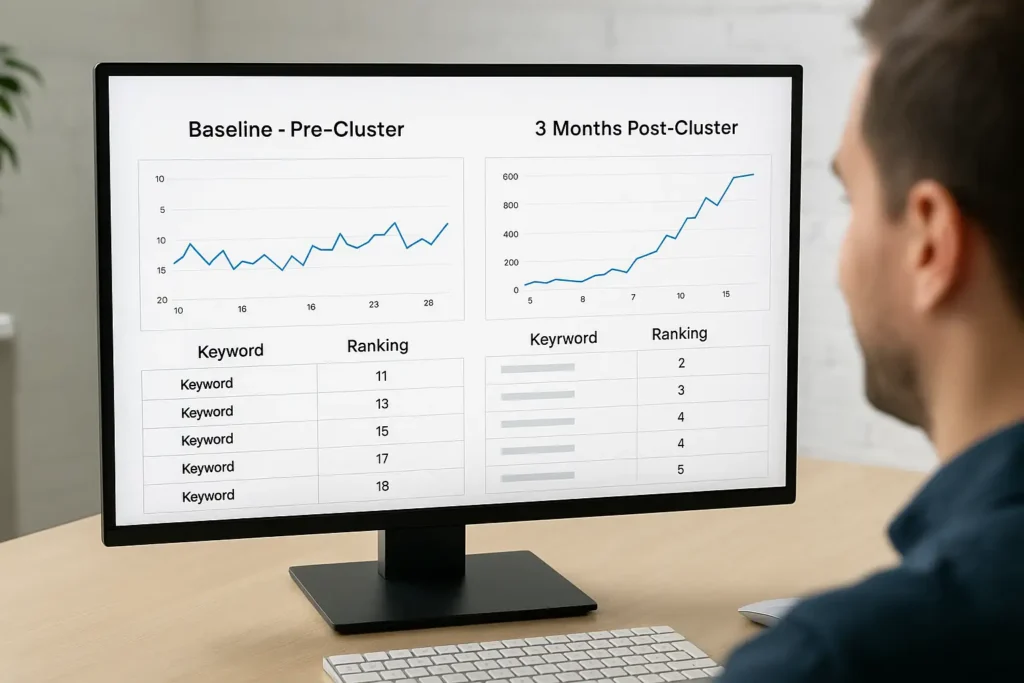We still remember when stuffing your content with keywords felt like you’d cracked some secret code. Those days are long gone, though. Today’s search engines are wiser, and they look for websites that truly know their stuff.
That’s brilliant news if you’ve got real expertise to share. You can utilise content cluster strategies to demonstrate what you know, and it’ll make search engines notice you.
At Motifo, we’ve seen how content clusters can change struggling websites into strong authority sources. This conversion is pretty wild to watch.
In this article, we’ll walk you through building a connected content network for your website. It’ll improve your rankings, sure, but it will also help you establish yourself as someone who really knows their field.
Let’s explore this content cluster strategy to make you a trusted voice in your industry. Read on to learn more.
What are Content Clusters: The Heart of Modern SEO
Content clusters refer to a group of interconnected website pages and posts based on a certain topic. These clusters work like a neat old library where librarians group all the books by topic, each pointing you toward something else that’s related.
This strategy has three main elements:
- A central pillar page that covers your main topic broadly.
- Smaller cluster pages exploring specific subtopics in detail.
- Strategic internal links that tie everything together.
We’re going to break down each of these components below.
Pillar Page Strategy: Your Content Hub
Pillar pages work with the main topic at a high level while pointing visitors towards more detailed information. For instance, “Complete Guide to Content Marketing” or “Everything You Need to Know About Website Design” are pillar pages serving this exact purpose.
Think of your pillar page as the lobby of a grand hotel. It shows you everything you need to know about the place at first glance, but it also makes you curious about what’s behind all those other doors.
The most effective pillar pages we’ve seen answer the main questions while hinting at the information available on your cluster pages. In other words, they give people enough to feel informed but leave them wanting to explore deeper.
Well, you can say that pillar pages are trailers for your expertise.
The Role of Topic Cluster Pages
Cluster pages provide detailed explanations of specific concepts. They answer those “how do I…” questions that keep people up at night Googling. The great thing about cluster pages is how they offer comparisons, reviews, or in-depth analysis of particular aspects of your main topic.
Consider each page and post as a room in the hotel we mentioned earlier. These cluster pages always link back to your pillar page (the hotel lobby), which strengthens its authority in the process.
This interconnected approach guides your visitors to certain solutions (yes, we’re basically content matchmakers here).
Strategic Internal Linking: Connecting the Dots
Your internal links unite your separate pages on a given topic. Imagine those links as the hallways in that aforementioned grand hotel (connecting rooms to the lobby). They help people move smoothly from room to room without getting lost.
Every cluster page should link back to your pillar page using descriptive anchor text that tells readers what they’ll find. And your pillar page should connect back to all relevant cluster content. It’ll create clear pathways for topic exploration.
Why Content Clusters Boost Your SEO Authority
Your content clusters show Google you’re covering a topic thoroughly. It establishes you and your website as an expert on a specific topic. The beauty of this approach is that you’re also giving your visitors what they need without sending them elsewhere, which would leave them feeling unfulfilled (or give traffic to a competitor).

So, what exactly makes content clusters improve your authority? Let’s find out.
Increased Topical Authority
When you cover a topic perfectly with connected content, Google starts treating you like the neighbourhood expert everyone turns to. That’s why businesses using this approach often see their rankings improve for search terms they never even thought to target.
It’s like Google suddenly realises you’re the person with all the answers and starts sending more qualified traffic your way.
Improved User Experience and Engagement
The great thing about content clusters is that they make it easy for your visitors to find precisely what they’re after. Picture this: someone might land on your main page for the overview, then happily click through to your detailed articles for the nitty-gritty details. This keeps them glued to your content longer.
And here’s the kicker… Google loves these positive engagement signals.
What this means for your business:
- Your visitors can move across your content without getting lost.
- They don’t need to go to your competitor sites for complete answers (because you’ve become their content buffet).
- They stick around to read your valuable, connected articles.
The result? Google sees your site as truly helpful rather than just another keyword-obsessed website. Simply put, it translates to better rankings and more visibility for you.
How to Implement a Successful Content Cluster Strategy
After understanding why content clusters work so well, the question becomes, how do you make this happen for your business? An effective content cluster strategy depends on three main areas: choosing your core topics, researching the right keywords, and connecting everything with internal links.
Here’s how to tackle each step without getting overwhelmed.
Identifying Your Core Pillar Topics
Your pillar topics need to hit the sweet spot: broad enough to support multiple cluster pages but focused enough to match what your audience cares about. The best place to start? Combine the questions your customers ask most often and the things your competitors are covering well.
Based on our experience, the trick is to pick three to five strong topics to coordinate with your expertise and build from there (honestly, most people pick way too many topics and dilute everything).
Keyword Research for Cluster Content
In this stage, you need to find out what your potential customers are searching for. While your pillar page targets broader terms, your cluster pages should focus on longer, more specific searches.
Tools like AnswerThePublic are gold mines here. Use them to identify primary keywords for your pillar page, long-tail keywords for cluster pages, and related questions your audience is asking.
Internal Linking: Best Practices
As you know from our earlier discussion, your internal links connect separate pages and create a powerful content cluster effect. You must ensure every cluster page links back to your pillar page using descriptive anchor text, while your pillar page connects to all relevant cluster content.
The steps below work best for your linking strategy:
- Use natural, descriptive anchor text instead of generic phrases like “Click Here”.
- Include 2-3 links from your pillar page to each cluster page.
- Connect related cluster pages when it makes sense for your readers.
- Avoid over-linking. Quality connections matter more than quantity.
This constructs a web that strengthens every single page about a certain broad topic and helps visitors find exactly what they need.
How to Handle Common Content Cluster Challenges
Look, we’ve been managing content clusters for years now, and there are two problems that appear every single time. Keyword cannibalisation (your pages start competing with each other instead of working together) and outdated content (that goes stale faster than office coffee left on the counter overnight).

Once you’ve seen these issues enough times, they become pretty predictable. You’ll spot them coming from a mile away.
Let us walk you through what we’ve learnt about catching these problems before they ruin your rankings.
Avoiding Keyword Cannibalisation
Imagine you’ve written three different pages about similar topics, and instead of backing each other, they’re having a wrestling match in Google’s search results. None of them win because Google can’t figure out which one deserves a front position.
Trust us, watching your own content sabotage itself is one of the most frustrating things you’ll experience in SEO.
Here’s how you can prevent this problem from happening in the first place:
- Map out your keywords before you start writing. This gives you a clear picture of what ground each page should cover.
- Give each page its own distinct focus and search intent. It means you’re thinking carefully about what specific question or need each piece addresses.
- Use specific angles for cluster pages rather than broad topics.
For example, if your pillar page covers “email marketing basics”, create cluster pages like “email subject line best practices” rather than “email marketing fundamentals”. That way, each page has its territory to dominate.
Auditing and Updating Cluster Content
Your content clusters require ongoing maintenance to stay effective, and honestly, this is where many people drop the ball. Search trends change, new information shows up, and your audience needs the latest update.
So what happens when you neglect this situation? Your outdated content signals to Google that you might not be the current authority on your topic anymore.
Keep your content fresh with these steps:
- Schedule regular checkups every six months. Treat it like a routine health exam for your content.
- Look for outdated statistics and broken internal links.
- Identify gaps where new cluster pages might strengthen your coverage.
- Update existing content with new data and insights.
Here’s a warning, though, and this one caught us off guard: don’t go overboard with updates. We had a client who got so enthusiastic about keeping things fresh that they were tweaking pages every few weeks. Their rankings started dropping.
Turns out Google interprets constant changes as instability rather than freshness. So, update your content when it’s needed instead of tweaking just for the sake of tweaking.
How to Measure the Impact of Your Content Clusters
You can measure your content cluster performance by tracking specific metrics to find its search visibility and business impact. The thing is, people get excited about building content clusters, spend weeks developing this beautiful web of interconnected articles, then sit back and… hope for the best.
It’s like planting a garden and never checking if anything’s growing at all.
We’ve been there. You pour your heart into creating these elaborate content structures, and three months later you’re squinting at Google Analytics wondering if any of it made an impact. The silence from your data dashboard can be deafening.
The solution is knowing what to measure before you even start writing. It’s similar to setting up a fitness tracker before you begin a workout routine. You need those baseline numbers, or you’ll never know if you’re making progress or just spinning your wheels.
So, start by establishing baseline measurements before implementing your clusters. And make sure to monitor changes monthly across traffic, rankings, and engagement patterns.

We’ll explain now which numbers to watch and how they connect to your overall marketing goals.
Key Performance Indicators (KPIs) to Track
Your content cluster’s success comes down to specific, measurable outcomes directly impacting your business. In our experience, these metrics give you the clearest picture of cluster performance (they’re surprisingly revealing once you start paying attention):
- Organic Traffic Growth: Keep an eye on increases to both pillar and cluster pages compared to your baseline. For instance, if your pillar page was getting 500 visits monthly, look for steady growth to 800+ visits within six months.
- Keyword Ranking Improvements: Your target terms and related searches deserve close attention here. Your “email marketing” pillar might jump from page 3 to page 1, while cluster pages start ranking for terms like “email automation tools”.
- Internal Link Click-Through Rates: Measure how often visitors move between pillar and cluster content. A healthy cluster sees 15-25% of pillar page visitors clicking through to related articles.
- Time on Page and Bounce Rates: Engagement quality for your cluster content shows up in these numbers. Well-connected clusters typically show 3+ minute average sessions and bounce rates below 60%.
- Lead Generation and Conversions: Count actual business results from cluster pages. Track contact form submissions, newsletter signups, or consultation requests originating from your cluster content.
- Search Visibility Expansion: Sometimes Google surprises you with rankings on topic-related keywords you didn’t specifically target. For example, your content marketing cluster might suddenly rank for “blog writing tips” without you trying.
- Page Authority Improvements: Use tools like Ahrefs or SEMrush to measure domain strength changes. Look for your cluster pages gaining backlinks and authority scores over time.
Check these numbers monthly to identify trends early, because these emerging patterns can guide your entire content strategy.
Start Building Your Content Authority Today
Traditional SEO approaches leave many businesses struggling with poor rankings and scattered articles. Content clusters solve these problems by creating interconnected expertise hubs that Google recognises and rewards with better visibility.
In this article, we’ve shown you how to recognise pillar topics, research cluster keywords, implement strategic internal linking, avoid common errors, and measure your success effectively through proven metrics.
Stop letting your competitors dominate your industry’s search results. Contact our Brisbane SEO experts today and explore how we can build content clusters that establish your business as the trusted authority customers seek.
